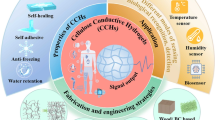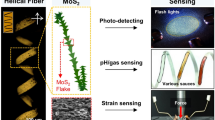Abstract
Carbon nanofiber (CNF) is a promising nanomaterial to prepare the strain sensor due to the simple preparation and high controllability. Despite the sensors have been developed based on CNFs, it is still a challenge to detect the full deformation with high sensitivity. In this study, we prepare the aligned semitransparent graphene-reinforced CNF membrane (G-CNFM) by electrospinning. The anisotropy of sensing performance of the ultrathin sensor was demonstrated. The sensor along parallel direction shows high sensitivity in the wide strain range of 0.1–38%. Moreover, the high durability can be obtained for over 1000 cycles at the subtle strain of 0.1% and high strain of 30%. The high linearity was also obtained under the low strain. The low sensitivity was exhibited along perpendicular direction, and the sensor was still working for 1000 cycles at 60% strain. The sensing mechanism was analyzed according to the microstructures of cracks. The thickness, the aligned degree and the width of G-CNFM and the thickness of TPU substrate show effects on the strain levels and sensitivity. The strain sensors can detect the full deformation caused by personal physiological movements and body motions. The sensor made using aligned G-CNFM may be used for various smart wearable electronic applications.
Graphical Abstract







Similar content being viewed by others
References
Amjadi M, Kyung KU, Park I, Sitti M (2016) Stretchable, skin-mountable, and wearable strain sensors and their potential applications: a review. Adv Funct Mater 26:1678–1698. https://doi.org/10.1002/adfm.201504755
Liu H, Li Q, Zhang S, Yin R, Liu X, He Y, Dai K, Shan C, Guo J, Liu C, Shen C, Wang X, Wang N, Wang Z, Wei R, Guo Z (2018) Electrically conductive polymer composites for smart flexible strain sensors: a critical review. J Mater Chem C 6:12121–12141. https://doi.org/10.1039/c8tc04079f
Lee JH, Kim J, Liu D, Guo F, Shen X, Zheng Q, Jeon S, Kim JK (2019) Highly aligned, anisotropic carbon nanofiber films for multidirectional strain sensors with exceptional selectivity. Adv Funct Mater 29:1901623. https://doi.org/10.1002/adfm.201901623
Xu H, Lv Y, Qiu D, Zhou Y, Zeng H, Chu Y (2019) An ultra-stretchable, highly sensitive and biocompatible capacitive strain sensor from an ionic nanocomposite for on-skin monitoring. Nanoscale 11:1570–1578. https://doi.org/10.1039/c8nr08589g
Ahn S, Cho Y, Park S, Kim J, Sun J, Ahn D, Lee M, Kim D, Kim T, Shin H, Park JJ (2020) Wearable multimode sensors with amplified piezoelectricity due to the multi local strain using 3D textile structure for detecting human body signals. Nano Energy 74:104932. https://doi.org/10.1016/j.nanoen.2020.104932
Garcia PA, Khoshnam M, Menon C (2020) Wearable device to monitor back movements using an inductive textile sensor. Sensors 20:905. https://doi.org/10.3390/s20030905
Khan H, Razmjou A, Ebrahimi Warkiani M, Kottapalli A, Asadnia M (2018) Sensitive and flexible polymeric strain sensor for accurate human motion monitoring. Sensors 18:418. https://doi.org/10.3390/s18020418
Amjadi M, Pichitpajongkit A, Lee S, Ryu S, Park I (2014) Highly stretchable and sensitive strain sensor based on silver nanowire-elastomer nanocomposite. ACS Nano 8:5154–5163. https://doi.org/10.1021/nn501204t
Sang S, Liu L, Jian A, Duan Q, Ji J, Zhang Q, Zhang W (2018) Highly sensitive wearable strain sensor based on silver nanowires and nanoparticles. Nanotechnology 29:255202. https://doi.org/10.1088/1361-6528/aabbba
Chen S, Wei Y, Yuan X, Lin Y, Liu L (2016) A highly stretchable strain sensor based on a graphene/silver nanoparticle synergic conductive network and a sandwich structure. J Mater Chem C 4:4304–4311. https://doi.org/10.1039/c6tc00300a
Yang Z, Wang DY, Pang Y, Li YX, Wang Q, Zhang TY, Wang JB, Liu X, Yang YY, Jian JM, Jian MQ, Zhang YY, Yang Y, Ren TL (2018) Simultaneously detecting subtle and intensive human motions based on a silver nanoparticles bridged graphene strain sensor. ACS Appl Mater Interfaces 10:3948–3954. https://doi.org/10.1021/acsami.7b16284
Zhou J, Xu X, **n Y, Lubineau G (2018) Coaxial thermoplastic elastomer-wrapped carbon nanotube fibers for deformable and wearable strain sensors. Adv Funct Mater 28:1705591. https://doi.org/10.1002/adfm.201705591
Hao B, Mu L, Ma Q, Yang S, Ma PC (2018) Stretchable and compressible strain sensor based on carbon nanotube foam/polymer nanocomposites with three-dimensional networks. Compos Sci Technol 163:162–170. https://doi.org/10.1016/j.compscitech.2018.05.017
Wang Y, Wang Y, Wan B, Han B, Cai G, Chang R (2018) Strain and damage self-sensing of basalt fiber reinforced polymer laminates fabricated with carbon nanofibers/epoxy composites under tension. Compos Part A Appl S 113:40–52. https://doi.org/10.1016/j.compositesa.2018.07.017
Yan T, Wang Z, Wang Y, Pan Z (2018) Carbon/graphene composite nanofiber yarns for highly sensitive strain sensors. Mater Design 143:214–223. https://doi.org/10.1016/j.matdes.2018.02.006
Zheng Y, Li Y, Dai K, Wang Y, Zheng G, Liu C, Shen C (2018) A highly stretchable and stable strain sensor based on hybrid carbon nanofillers/polydimethylsiloxane conductive composites for large human motions monitoring. Compos Sci Technol 156:276–286. https://doi.org/10.1016/j.compscitech.2018.01.019
Liu Y, Zheng H, Liu M (2018) High performance strain sensors based on chitosan/carbon black composite sponges. Mater Des 141:276–285. https://doi.org/10.1016/j.matdes.2017.12.046
Liu K, Zhou Z, Yan X, Meng X, Tang H, Qu K, Gao Y, Li Y, Yu J, Li L (2019) Polyaniline nanofiber wrapped fabric for high performance flexible pressure sensors. Polymers 11:1120. https://doi.org/10.3390/polym11071120
He Y, Gui Q, Wang Y, Wang Z, Liao S, Wang Y (2018) A polypyrrole elastomer based on confined polymerization in a host polymer network for highly stretchable temperature and strain sensors. Small 14:1800394. https://doi.org/10.1002/smll.201800394
Zhang M, Wang C, Wang H, Jian M, Hao X, Zhang Y (2017) Carbonized cotton fabric for high-performance wearable strain sensors. Adv Funct Mater 27:1604795. https://doi.org/10.1002/adfm.201604795
Wang C, Li X, Gao E, Jian M, **a K, Wang Q, Xu Z, Ren T, Zhang Y (2016) Carbonized silk fabric for ultrastretchable, highly sensitive, and wearable strain sensors. Adv Mater 28:6640–6648. https://doi.org/10.1002/adma.201601572
Yan T, Wang Z, Pan Z (2018) Flexible strain sensors fabricated using carbon-based nanomaterials: a review. Curr Opin Solid State Mater Sci 22:213–228. https://doi.org/10.1016/j.cossms.2018.11.001
Zhang L, Aboagye A, Kelkar A, Lai C, Fong H (2013) A review: carbon nanofibers from electrospun polyacrylonitrile and their applications. J Mater Sci 49:463–480. https://doi.org/10.1007/s10853-013-7705-y
Wu S, Zhang J, Ladani RB, Ravindran AR, Mouritz AP, Kinloch AJ, Wang CH (2017) Novel electrically conductive porous PDMS/carbon nanofiber composites for deformable strain sensors and conductors. ACS Appl Mater Interfaces 9:14207–14215. https://doi.org/10.1021/acsami.7b00847
Zhu J, Wei S, Ryu J, Guo Z (2011) Strain-sensing elastomer/carbon nanofiber “metacomposites”. J Phys Chem C 115:13215–13222. https://doi.org/10.1021/jp202999c
Zhang F, Wu S, Peng S, Sha Z, Wang CH (2019) Synergism of binary carbon nanofibres and graphene nanoplates in improving sensitivity and stability of stretchable strain sensors. Compos Sci Technol 172:7–16. https://doi.org/10.1016/j.compscitech.2018.12.031
Onyilagha O, Ding Y, Zhu Z (2019) Freestanding electrospun nanfibrous materials embedded in elastomers for stretchable strain sensors. Micro Nanotechnol Sens Syst Appl. https://doi.org/10.1117/12.2517160
Ding Y, Yang J, Tolle CR, Zhu Z (2016) A highly stretchable strain sensor based on electrospun carbon nanofibers for human motion monitoring. RSC Adv 6:79114–79120. https://doi.org/10.1039/c6ra16236c
Wang Q, Jian M, Wang C, Zhang Y (2017) Carbonized silk nanofiber membrane for transparent and sensitive electronic skin. Adv Funct Mater 27:1605657. https://doi.org/10.1002/adfm.201605657
Yan T, Tian L, Pan Z (2016) Structures and mechanical properties of plied and twisted polyacrylonitrile nanofiber yarns fabricated by a multi-needle electrospinning device. Fibers Polym 17:1627–1633. https://doi.org/10.1007/s12221-016-6553-1
Roh JS (2008) Structural study of the activated carbon fiber using laser Raman spectroscopy. Carbon Lett 9:127–130. https://doi.org/10.5714/CL.2008.9.2.127
Acknowledgements
Funding support from Third-Priority Academic Program Development of Jiangsu Higher Education Institutions, Primary Research and Development Plan of Jiangsu Province (Grant Number BE2019045) and Jiangsu Planned Projects for Postdoctoral Research Funds (Grant Number 2020Z251).
Author information
Authors and Affiliations
Corresponding author
Ethics declarations
Conflict of interest
There are no conflicts to declare.
Additional information
Handling Editor: Naiqin Zhao.
Publisher's Note
Springer Nature remains neutral with regard to jurisdictional claims in published maps and institutional affiliations.
Supplementary Information
Below is the link to the electronic supplementary material.
Rights and permissions
About this article
Cite this article
Yan, T., Wu, Y. & Pan, Z. Anisotropy of resistance-type strain sensing networks based on aligned carbon nanofiber membrane. J Mater Sci 56, 6292–6305 (2021). https://doi.org/10.1007/s10853-020-05736-7
Received:
Accepted:
Published:
Issue Date:
DOI: https://doi.org/10.1007/s10853-020-05736-7




